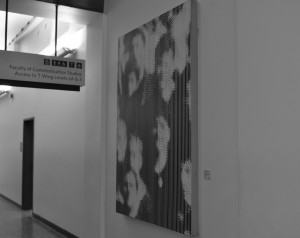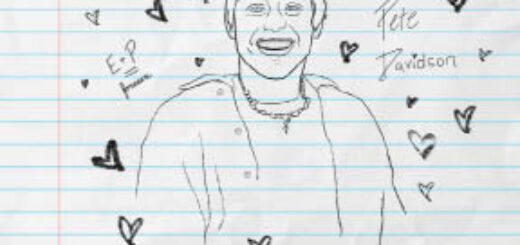Q & Arts: Chris Cran
Calgary-based painter concerns himself with illusion in his works
Kari Pedersen
Arts Editor

Walk through the second floor of the O wing to see the works of Chris Cran on display. The Calgary based painter has been reviewed by many, including the New York Times.
Photo: Albina Khouzina
Chris Cran, a Calgary based painter who has had his work reviewed by many around North America including the New York Times, focuses his work on perceptions and illusion. But as a sectional instructor at ACAD, he wants people to see art as a journey of self-discovery. An opportunity for people to think and feel in their own ways.
The Reflector: Your pieces often have interesting visual tricks or components to them. What is it about this concept that you feel catches the eye of a viewer?
Chris Cran: I remember, in my young days as an artist, someone saying that the mind cannot entertain two things at the same time. My response to this was to present two, or several things which cause the mind to travel and which, in the apprehension of those particular “things”, enjoys the travelling. Examples of two things — an image and the particular way it is made — the juxtaposition of two elements — an image and a title — an image and a framing device. Any number of possibilities.
TR: There are some similarities of your work to pop art. What artists have inspired your work, and if not who, then what has inspired your work?
CC: When I was 15 or 16 I heard “Highway 61” by Bob Dylan and it was a revelation. The surreal, casual, sassy language seemed so familiar. I began painting when I was 19 and I was most fascinated by Picasso, Matisse, Beckmann, David Milne, Vermeer. Later, artists like Warhol, Richter, Agnes Martin. My interest in some artists faded and others rose to the surface. Some have potently stayed with me such as Roy Lichtenstein, Matisse, Philip Guston, Raoul Dufy, Fernand Leger, Juan Gris, Cezanne and locally Ron Moppett and John Will. I am absolutely interested in individual works of art that surprise me when I happen upon them, whether I know of the artist or not. I saw a Walter Sickert painting from the mid 1930’s in the Beaverbrook Art Gallery selection at the Glenbow Museum last year that prefigured pop painting by twenty years. Several days ago, at the Hamilton Art Gallery, I saw a Charles Comfort painting from 1929 that did the same thing. Roaul Dufy was misregistering colour and line forty years before Warhol.
TR: You have said in the past that you like to leave room for interpretation in your work, not a definite message. How do you think that changes the way viewers look at your pieces?
CC: Something I learned specifically from Cezanne — do half the work. Let the viewer finish the work. In the case of Cezanne, he gave brushstrokes, some form, and precise colour, which translate into light and temperature. The viewer follows those few suggestions and supplies the space in the work.
TR: What upcoming art and culture projects in Calgary are you most excited for?
CC: Contemporary Calgary, National Music Centre and C-Space
TR: Why do you think the art and culture scene is so important for university students to be a part of?
CC: Art is about pleasure, feeling, thinking, discovery, self-discovery, sometimes all in a moment. It is useful to help increase attention spans. If it is not, then it is not. The art scene is a community and there is plenty of exchange there.
TR: What is your advice for university students?
CC: Learning is not about what one is taught, it is about what one learns. Who is responsible for that learning? The learner. Get excited. If you cannot get excited, there might be a job waiting for you at 7/11.
If you are interested in seeing one of Cran’s pieces, check out the hallway in second floor T wing outside of the O wing, Mount Royal happens to have a big one on display.




